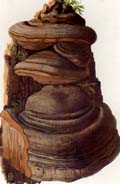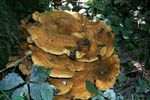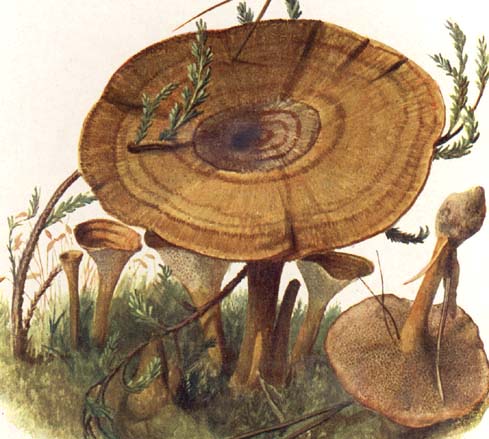 Key to Gilled Mushrooms Key
Key to Gilled Mushrooms KeyThis is a key to gilled mushrooms, that is, mushrooms having a definite cap with a fertile surface consisting of gills. The fruiting body usually also has a stem, although that may be lateral or absent (usually, then, the mushroom is growing from wood). You can use this key to identify mushrooms that you find.
 Polyporaceae Family
Polyporaceae FamilyFertile surface usually a layer of vertical tubes, of which the mouths are visible as pores on the underside of the cap or shelf.
Fruiting bodies usually tougher or harder than the "normal" gilled mushrooms, being leathery, corky, or woody. But they can be quite tender while actively growing
Once grown, they do not decay easily, remaining on the substrate for months or years
They often grow on wood, although a few are terrestrial (even those are usually growing on buried wood)
Fruiting body is usually a flat shelf, or hoof-shaped, protruding directly from the substrate, although sometimes it may have a short stalk.
Some forms never grow away from the substrate at all, so that all that is visible of the fruiting body are the pores.
Sometimes the pores are so minute that the fertile surface seems solid, until you look closely
 Terrestriopolypore Subfamily
Terrestriopolypore SubfamilyGrowing on ground
 Small Terrestriopolypore Tribe
Small Terrestriopolypore TribeIf your small terrestrial polypore does not fit the diagnosis for Coltricia, then you probably have a young specimen of some other genus
Coltricia Genus S. F. Gray

Diagnosis
- Centrally stalked, thin-fleshed, with clearly zonate cap
Narrow down your identification:
Coltricia cinnamomeaFlesh very thin (up to 1 mm).
Cap up to two inches across, silky to velutinate, brown to reddish brown; margin sometimes torn
 Coltricia perennis
Coltricia perennisYellow-brown to brown cap up to 4 inches wide, 5 mm thick.
Hairs on cap are also proportionately larger than those on Coltricia cinnamomea






 Key to Gilled Mushrooms Key
Key to Gilled Mushrooms Key Polyporaceae Family
Polyporaceae Family Small Terrestriopolypore Tribe
Small Terrestriopolypore Tribe
 Coltricia perennis
Coltricia perennis




